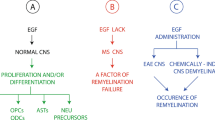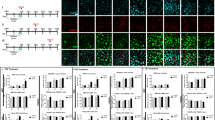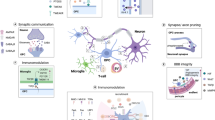Abstract
Amongst the many soluble extracellular factors stimulating intracellular signal transduction pathways and driving cellular processes such as proliferation, differentiation and survival, insulin-like growth factors (IGFs) stand out as indispensable factors for proper oligodendrocyte differentiation and accompanying myelin production. Owing to its potent myelinogenic capacity and its neuroprotective properties, IGFs hold therapeutic potential in demyelinating and neurodengenerative diseases. However, the IGF system is comprised of a complex molecular network involving regulatory binding proteins, proteases, cell surface and extracellular matrix components which orchestrate IGF-specific functions. Thus, the complexity by which these factors are tightly regulated makes a simplistic therapeutic approach towards treating demyelinating conditions unfeasible. In the present review, we address these issues and consider current therapeutic prospects of oligodendrocyte-targeted IGF-based therapies.


Similar content being viewed by others
References
Aberg, N. D., Brywe, K. G., & Isgaard, J. (2006). Aspects of growth hormone and insulin-like growth factor-I related to neuroprotection, regeneration, and functional plasticity in the adult brain. Scientific World Journal, 6, 53–80.
Aberg, N. D., Johansson, U. E., Aberg, M. A., Hellstrom, N. A., Lind, J., Bull, C., et al. (2007). Peripheral infusion of insulin-like growth factor-I increases the number of newborn oligodendrocytes in the cerebral cortex of adult hypophysectomized rats. Endocrinology, 148, 3765–3772.
Adachi, T., Takanaga, H., Kunimoto, M., & Asou, H. (2005). Influence of LIF and BMP-2 on differentiation and development of glial cells in primary cultures of embryonic rat cerebral hemisphere. Journal of Neuroscience Research, 79, 608–615.
Anlar, B., Sullivan, K. A., & Feldman, E. L. (1999). Insulin-like growth factor-I and central nervous system development. Hormone Metabolic Research, 31, 120–125.
Baron, W., Decker, L., Colognato, H., & Ffrench-Constant, C. (2003). Regulation of integrin growth factor interactions in oligodendrocytes by lipid raft microdomains. Current Biology, 13, 151–155.
Barres, B. A., Schmid, R., Sendnter, M., & Raff, M. C. (1993). Multiple extracellular signals are required for long-term oligodendrocyte survival. Development, 118, 283–295.
Baxter, R. C., Martin, J. L., & Beniac, V. A. (1989). High molecular weight insulin-like growth factor binding protein complex. Purification and properties of the acid-labile subunit from human serum. Journal of Biological Chemistry, 264, 11843–11848.
Beck, K. D., Powell-Braxton, L., Widmer, H. R., Valverde, J., & Hefti, F. (1995). Igf1 gene disruption results in reduced brain size, CNS hypomyelination, and loss of hippocampal granule and striatal parvalbumin-containing neurons. Neuron, 14, 717–730.
Bichell, D. P., Kikuchi, K., & Rotwein, P. (1992). Growth hormone rapidly activates insulin-like growth factor I gene transcription in vivo. Molecular Endocrinology, 6, 1899–1908.
Blum, W. F., Bertsson-Wikland, K., Rosberg, S., & Ranke, M. B. (1993). Serum levels of insulin-like growth factor I (IGF-I) and IGF binding protein 3 reflect spontaneous growth hormone secretion. Journal of Clinical Endocrinology and Metabolism, 76, 1610–1616.
Bogler, O., Wren, D., Barnett, S. C., Land, H., & Noble, M. (1990). Cooperation between two growth factors promotes extended self-renewal and inhibits differentiation of oligodendrocyte-type-2 astrocyte (O-2A) progenitor cells. Proceedings of the National Academy of Science of the United States of America, 87, 6368–6372.
Boillee, S., & Cleveland, D. W. (2004). Gene therapy for ALS delivers. Trends in Neuroscience, 27, 235–238.
Bondy, C., Werner, H., Roberts, C. T., & LeRoith, D. Jr. (1992). Cellular pattern of type-I insulin-like growth factor receptor gene expression during maturation of the rat brain: Comparison with insulin-like growth factors I and II. Neuroscience, 46, 909–923.
Carro, E., Spuch, C., Trejo, J. L., Antequera, D., & Torres-Aleman, I. (2005). Choroid plexus megalin is involved in neuroprotection by serum insulin-like growth factor I. Journal of Neuroscience, 25, 10884–10893.
Carson, M. J., Behringer, R. R., Brinster, R. L., & McMorris, F. A. (1993). Insulin-like growth factor I increases brain growth and central nervous system myelination in transgenic mice. Neuron, 10, 729–740.
Chen, C., Zhu, Y. F., Liu, X. J., Lu, Z. X., Xie, Q., & Ling, N. (2001). Discovery of a series of nonpeptide small molecules that inhibit the binding of insulin-like growth factor (IGF) to IGF-binding proteins. Journal of Medical Chemistry, 44, 4001–4010.
Cheng, C. M., Joncas, G., Reinhardt, R. R., Farrer, R., Quarles, R., Janssen, J., et al. (1998). Biochemical and morphometric analyses show that myelination in the insulin-like growth factor 1 null brain is proportionate to its neuronal composition. Journal of Neuroscience, 18, 5673–5681.
Cheng, H. L., Russell, J. W., & Feldman, E. L. (1999). IGF-I promotes peripheral nervous system myelination. Annals of New York Academy of Science, 883, 124–130.
Chesik, D., De Keyser, J., Glazenburg, L., & Wilczak, N. (2006). Insulin-like growth factor binding proteins: regulation in chronic active plaques in multiple sclerosis and functional analysis of glial cells. European Journal of Neuroscience, 24, 1645–1652.
Chesik, D., De Keyser, J., & Wilczak, N. (2004). Involvement of insulin-like growth factor binding protein-2 in activated microglia as assessed in post mortem human brain. Neuroscience Letters, 362, 14–16.
Cohen, R. I., Marmur, R., Norton, W. T., Mehler, M. F., & Kessler, J. A. (1996). Nerve growth factor and neurotrophin-3 differentially regulate the proliferation and survival of developing rat brain oligodendrocytes. Journal of Neuroscience, 16, 6433–6442.
Cui, Q. L., & Almazan, G. (2007). IGF-I-induced oligodendrocyte progenitor proliferation requires PI3K/Akt, MEK/ERK, and Src-like tyrosine kinases. Journal of Neurochemistry, 100, 1480–1493.
De Keyser, J., Wilczak, N., & Goossens, A. (1994). Insulin-like growth factor-I receptor densities in human frontal cortex and white matter during aging, in Alzheimer’s disease, and in Huntington’s disease. Neuroscience Letters, 172, 93–96.
Feldman, E. L., Sullivan, K. A., Kim, B., & Russell, J. W. (1997). Insulin-like growth factors regulate neuronal differentiation and survival. Neurobiology of Disease, 4, 201–214.
Frederick, T. J., Min, J., Altieri, S. C., Mitchell, N. E., & Wood, T. L. (2007). Synergistic induction of cyclin D1 in oligodendrocyte progenitor cells by IGF-I and FGF-2 requires differential stimulation of multiple signaling pathways. Glia, 55, 1011–1022.
Fressinaud, C. (2005). Repeated injuries dramatically affect cells of the oligodendrocyte lineage: effects of PDGF and NT-3 in vitro. 555–566. Glia, 49, 555–66.
Garcia-Segura, L. M., Perez, J., Pons, S., Rejas, M. T., & Torres-Aleman, I. (1991). Localization of insulin-like growth factor I (IGF-I)-like immunoreactivity in the developing and adult rat brain. Brain Research, 560, 167–174.
Garwood, J., Garcion, E., Dobbertin, A., Heck, N., Calco, V., Ffrench-Constant, C., et al. (2004). The extracellular matrix glycoprotein Tenascin-C is expressed by oligodendrocyte precursor cells and required for the regulation of maturation rate, survival and responsiveness to platelet-derived growth factor. European Journal of Neuroscience, 20, 2524–2540.
Genoud, S., Maricic, I., Kumar, V., & Gage, F. H. (2005). Targeted expression of IGF-1 in the central nervous system fails to protect mice from experimental autoimmune encephalomyelitis. Journal of Neuroimmunology, 168, 40–45.
Hsieh, J., Aimone, J. B., Kaspar, B. K., Kuwabara, T., Nakashima, K., & Gage, F. H. (2004). IGF-I instructs multipotent adult neural progenitor cells to become oligodendrocytes. Journal of Cell Biology, 164, 111–122.
Hu, J. G., Fu, S. L., Wang, Y. X., Li, Y., Jiang, X. Y., Wang, X. F., et al. (2008). Platelet-derived growth factor-AA mediates oligodendrocyte lineage differentiation through activation of extracellular signal-regulated kinase signaling pathway. Neuroscience, 151, 138–147.
Jackson, E. L., Garcia-Verdugo, J. M., Gil-Perotin, S., Roy, M., Quinones-Hinojosa, A., VandenBerg, S., et al. (2006). PDGFR alpha-positive B cells are neural stem cells in the adult SVZ that form glioma-like growths in response to increased PDGF signaling. Neuron, 51, 187–199.
Jones, J. I., & Clemmons, D. R. (1995). Insulin-like growth factors and their binding proteins: Biological actions. Endocrine Reviews, 16, 3–34.
Kaspar, B. K., Llado, J., Sherkat, N., Rothstein, J. D., & Gage, F. H. (2003). Retrograde viral delivery of IGF-1 prolongs survival in a mouse ALS model. Science, 301, 839–842.
Kooijman, R. (2006). Regulation of apoptosis by insulin-like growth factor (IGF)-I. Cytokine and Growth Factor Reviews, 17, 305–323.
Lelievre, V., Ghiani, C. A., Seksenyan, A., Gressens, P., & Waschek, J. A. (2006). Growth factor-dependent actions of PACAP on oligodendrocyte progenitor proliferation. Regulatory Peptides, 137, 58–66.
Li, W., Quigley, L., Yao, D. L., Hudson, L. D., Brenner, M., Zhang, B. J., et al. (1998). Chronic relapsing experimental autoimmune encephalomyelitis: effects of insulin-like growth factor-I treatment on clinical deficits, lesion severity, glial responses, and blood brain barrier defects. Journal of Neuropathology and Experimental Neurology, 57, 426–438.
Liu, J. P., Baker, J., Perkins, A. S., Robertson, E. J., & Efstratiadis, A. (1993). Mice carrying null mutations of the genes encoding insulin-like growth factor I (Igf-1) and type 1 IGF receptor (Igf1r). Cell, 75, 59–72.
Liu, X. J., Xie, Q., Zhu, Y. F., Chen, C., & Ling, N. (2001). Identification of a nonpeptide ligand that releases bioactive insulin-like growth factor-I from its binding protein complex. Journal of Biological Chemistry, 276, 32419–32422.
Loddick, S. A., Liu, X. J., Lu, Z. X., Liu, C., Behan, D. P., Chalmers, D. C., et al. (1998). Displacement of insulin-like growth factors from their binding proteins as a potential treatment for stroke. Proceedings of the National Academy of Sciences of the United States of America, 95, 1894–1898.
Mackay, K. B., Loddick, S. A., Naeve, G. S., Vana, A. M., Verge, G. M., & Foster, A. C. (2003). Neuroprotective effects of insulin-like growth factor-binding protein ligand inhibitors in vitro and in vivo. Journal of Cerebral Blood Flow and Metabolism, 23, 1160–1167.
Maile, L. A., & Holly, J. M. (1999). Insulin-like growth factor binding protein (IGFBP) proteolysis: Occurrence, identification, role and regulation. Growth Hormone and Insulin-like Growth Factor Research, 9, 85–95.
Mason, J. L., Xuan, S., Dragatsis, I., Efstratiadis, A., & Goldman, J. E. (2003). Insulin-like growth factor (IGF) signaling through type 1 IGF receptor plays an important role in remyelination. Journal of Neuroscience, 23, 7710–7718.
Mason, J. L., Ye, P., Suzuki, K., D’Ercole, A. J., & Matsushima, G. K. (2000). Insulin-like growth factor-1 inhibits mature oligodendrocyte apoptosis during primary demyelination. Journal of Neuroscience, 20, 5703–5708.
McKinnon, R. D., Matsui, T., Dubois-Dalcq, M., & Aaronson, S. A. (1990). FGF modulates the PDGF-driven pathway of oligodendrocyte development. Neuron, 5, 603–614.
McKinnon, R. D., Piras, G., Ida, J. A. Jr., & Dubois-Dalcq, M. (1993). A role for TGF-beta in oligodendrocyte differentiation. Journal of Cell Biology, 121, 1397–1407.
McMorris, F. A., & Dubois-Dalcq, M. (1988). Insulin-like growth factor I promotes cell proliferation and oligodendroglial commitment in rat glial progenitor cells developing in vitro. Journal of Neuroscience Research, 21, 199–209.
McMorris, F. A., Smith, T. M., DeSalvo, S., & Furlanetto, R. W. (1986). Insulin-like growth factor I/somatomedin C: a potent inducer of oligodendrocyte development. Proceedings of the National Academy of Sciences of the United States of America, 83, 822–826.
Mohan, S., & Baylink, D. J. (2002). IGF-binding proteins are multifunctional and act via IGF-dependent and -independent mechanisms. Journal of Endocrinology, 175, 19–31.
Mozell, R. L., & McMorris, F. A. (1991). Insulin-like growth factor I stimulates oligodendrocyte development and myelination in rat brain aggregate cultures. Journal of Neuroscience Research, 30, 382–390.
Noble, M., Murray, K., Stroobant, P., Waterfield, M. D., & Riddle, P. (1988). Platelet-derived growth factor promotes division and motility and inhibits premature differentiation of the oligodendrocyte/type-2 astrocyte progenitor cell. Nature, 333, 560–562.
Ogata, T., Iijima, S., Hoshikawa, S., Miura, T., Yamamoto, S., Oda, H., et al. (2004). Opposing extracellular signal-regulated kinase and Akt pathways control Schwann cell myelination. Journal of Neuroscience, 24, 6724–6732.
Oorschot, D. E., & McLennan, I. S. (1998). The trophic requirements of mature motoneurons. Brain Research, 789, 315–321.
Pang, Y., Zheng, B., Fan, L. W., Rhodes, P. G., & Cai, Z. (2007). IGF-1 protects oligodendrocyte progenitors against TNFalpha-induced damage by activation of PI3K/Akt and interruption of the mitochondrial apoptotic pathway. Glia, 55, 1099–1107.
Rechler, M. M., & Nissley, S. P. (1985). The nature and regulation of the receptors for insulin-like growth factors. Annual Review of Physiology, 47, 425–442.
Reinhardt, R. R., & Bondy, C. A. (1994). Insulin-like growth factors cross the blood-brain barrier. Endocrinology, 135, 1753–1761.
Rotwein, P., Burgess, S. K., Milbrandt, J. D., & Krause, J. E. (1988). Differential expression of insulin-like growth factor genes in rat central nervous system. Proceedings of the National Academy of Sciences of the United States of America, 85, 265–269.
Russo, V. C., Gluckman, P. D., Feldman, E. L., & Werther, G. A. (2005). The insulin-like growth factor system and its pleiotropic functions in brain. Endocrine Reviews, 26, 916–943.
Sendtner, M. (1995). Molecular biology of neurotrophic factors. Baillieres Clinical Neurology, 4, 575–591.
Thorne, R. G., Pronk, G. J., Padmanabhan, V., & Frey, W. H. (2004). Delivery of insulin-like growth factor-I to the rat brain and spinal cord along olfactory and trigeminal pathways following intranasal administration. Neuroscience, 127, 481–496.
Trejo, J. L., Carro, E., Lopez-Lopez, C., & Torres-Aleman, I. (2004). Role of serum insulin-like growth factor I in mammalian brain aging. Growth Hormone and Insulin-like Growth Factor Research, 14(Suppl A), S39–S43.
van Dam, P. S., & Aleman, A. (2004). Insulin-like growth factor-I, cognition and brain aging. European Journal of Pharmacology, 490, 87–95.
Vicario-Abejon, C., Yusta-Boyo, M. J., Fernandez-Moreno, C., & de Pablo, F. (2003). Locally born olfactory bulb stem cells proliferate in response to insulin-related factors and require endogenous insulin-like growth factor-I for differentiation into neurons and glia. Journal of Neuroscience, 23, 895–906.
Wang, Z., Colognato, H., & Ffrench-Constant, C. (2007). Contrasting effects of mitogenic growth factors on myelination in neuron-oligodendrocyte co-cultures. Glia, 55, 537–545.
Werther, G. A., Russo, V., Baker, N., & Butler, G. (1998). The role of the insulin-like growth factor system in the developing brain. Hormone Research, 49(Suppl 1), 37–40.
Wilczak, N., & De Keyser, J. (1997). Insulin-like growth factor-I receptors in normal appearing white matter and chronic plaques in multiple sclerosis. Brain Research, 772, 243–246.
Wilson, H. C., Onischke, C., & Raine, C. S. (2003). Human oligodendrocyte precursor cells in vitro: phenotypic analysis and differential response to growth factors. Glia, 44, 153–165.
Wilson, H. C., Scolding, N. J., & Raine, C. S. (2006). Co-expression of PDGF alpha receptor and NG2 by oligodendrocyte precursors in human CNS and multiple sclerosis lesions. Journal of Neuroimmunology, 176, 162–173.
Wood, T. L., Loladze, V., Altieri, S., Gangoli, N., Levison, S. W., Brywe, K. G., et al. (2007). Delayed IGF-1 administration rescues oligodendrocyte progenitors from glutamate-induced cell death and hypoxic-ischemic brain damage. Developmental Neuroscience, 29, 302–310.
Yao, D. L., Liu, X., Hudson, L. D., & Webster, H. D. (1995). Insulin-like growth factor I treatment reduces demyelination and up-regulates gene expression of myelin-related proteins in experimental autoimmune encephalomyelitis. Proceedings of the National Acadamy of Science of the United States of America, 92, 6190–6194.
Ye, P., Carson, J., & D’Ercole, A. J. (1995). In vivo actions of insulin-like growth factor-I (IGF-I) on brain myelination: studies of IGF-I and IGF binding protein-1 (IGFBP-1) transgenic mice. Journal of Neuroscience, 15, 7344–7356.
Ye, P., Kollias, G., & D’Ercole, A. J. (2007). Insulin-like growth factor-I ameliorates demyelination induced by tumor necrosis factor-alpha in transgenic mice. Journal Neuroscience Research, 85, 712–722.
Ye, P., Li, L., Richards, R. G., DiAugustine, R. P., & D’Ercole, A. J. (2002). Myelination is altered in insulin-like growth factor-I null mutant mice. Journal of Neuroscience, 22, 6041–6051.
Zawadzka, M., & Franklin, R. J. (2007). Myelin regeneration in demyelinating disorders: New developments in biology and clinical pathology. Current Opinions in Neurology, 20, 294–298.
Zeger, M., Popken, G., Zhang, J., Xuan, S., Lu, Q. R., Schwab, M. H., et al. (2007). Insulin-like growth factor type 1 receptor signaling in the cells of oligodendrocyte lineage is required for normal in vivo oligodendrocyte development and myelination. Glia, 55, 400–11.
Zeis, T., Schaeren-Wiemers, N. (2008). Lame ducks or fierce creatures?-The role of oligodendrocytes in multiple sclerosis. DOI 10.1007/s12031-008-9042-1.
Zhu, Y. F., Wang, X. C., Connors, P., Wilcoxen, K., Gao, Y., Gross, R., et al. (2003). Quinoline-carboxylic acids are potent inhibitors that inhibit the binding of insulin -like growth factor (IGF) to IGF-binding proteins. Bioorganic & Medicinal Chemistry Letters, 13, 1931–1934.
Acknowledgements
Daniel Chesik is a recipient of a grant from the Dutch foundation Stichting Multiple Sclerose Anders to which authors are indebted for supporting studies concerning insuline-like growth factor therapeutic potential in treating multiple sclerosis.
Author information
Authors and Affiliations
Corresponding author
Rights and permissions
About this article
Cite this article
Chesik, D., De Keyser, J. & Wilczak, N. Insulin-like Growth Factor System Regulates Oligodendroglial Cell Behavior: Therapeutic Potential in CNS. J Mol Neurosci 35, 81–90 (2008). https://doi.org/10.1007/s12031-008-9041-2
Received:
Revised:
Accepted:
Published:
Issue Date:
DOI: https://doi.org/10.1007/s12031-008-9041-2




